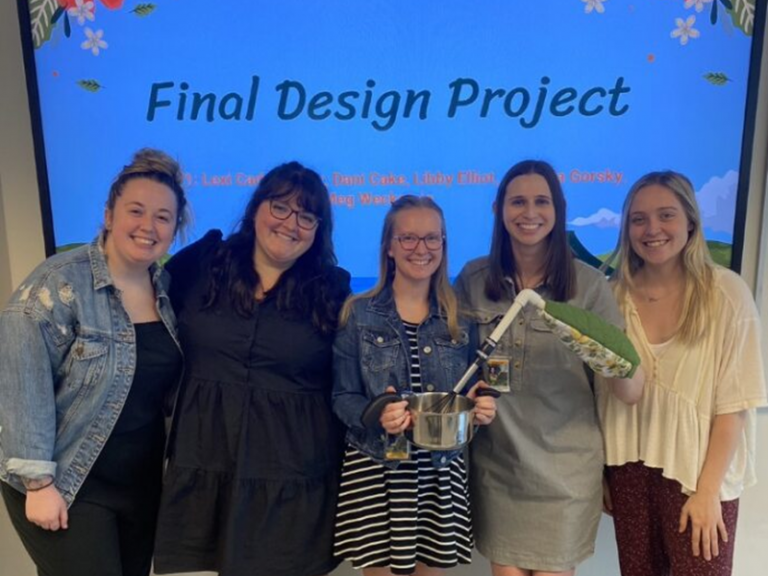
Danielle ”Dani“ Cake (center) and OTD classmates presenting their Final Design Project for the Adaptive/Technology Theory and Practice Course
My name is Dani Cake and I am a current Doctor of Occupational Therapy (OTD) student at the University of Pittsburgh School of Health and Rehabilitation Sciences (SHRS). I obtained my undergraduate degree in Rehabilitation Science at SHRS in December of 2021 with a certificate in Psycho-Social Issues in Rehabilitation and Personal Care.
Choosing Occupational Therapy
While growing up, I knew that I wanted to work in the health care field and assist various populations, but it was not until high school that I narrowed down my interest to occupational therapy.
Early on in high school I had the opportunity to volunteer at a local hospital during the summers and experience various areas of health and medicine, such as patient transport and therapy services. Volunteering in the therapy services department opened my eyes to the world of occupational therapy, which I previously knew nothing about. I gained exposure to occupational therapy through organizations such as Special Olympics and through shadowing experiences. After learning about the various avenues that occupational therapy could take, occupational therapy stood out from the other health and rehabilitation professions, and my decision to pursue this profession was solidified.
A Typical Day as an OTD Student
Since starting the Doctor of Occupational Therapy program, my typical day as an OTD student involves carpooling with my other program friends. We arrive early in the morning so we can socialize and get organized before our first class begins at 8 a.m. At noon, we have an hour-long break for lunch, and I prefer to eat on the rooftop patio of Bridgeside Point or take a quick walk on the walking trail near our building before we return for our 1 p.m. class.

Cake (standing) in the Skills for Living Lab demonstrating adaptive surfing techniques for individuals with muscular dystrophy on OTD classmate Amanda Gorsky for the Clinical Conditions 2 Course
The afternoon classes usually have a lecture component mixed with a lab or learning activity that includes moving around while we work in small groups, or with a partner. These classes usually run until around 5 p.m. and after class I drive back home and prepare for the next day — whether that is another day of classes, a fieldwork day, or a day off. My evenings are spent typing up extra notes, working on upcoming assignments, eating dinner, packing lunch for the next day, and taking time to relax and do something I enjoy, like going for a walk or reading.
Favorite OTD Courses

Cake (far left, front row) during the Dermatome Lab for the Neurobehavioral Science Course
My favorite course so far is a tie between Neurorehabilitation Theory and Practice or Adaptation/Technology Theory and Practice. Both courses are taught in the summer term and have hands-on lab components to practice the theoretical content we learn. Because they are summer courses, we apply a lot of what we learned in our previous courses, which challenges our clinical reasoning. I really enjoyed the content in both courses and found the information super-practical for the setting I see myself in in the future.
Opportunities in the OTD Program
The OTD program has so many amazing opportunities for students to develop their clinical and leadership skills, as well as to network with other people in the field.
In a few of my educational experiences, I have had an opportunity to participate in interprofessional events, clinical simulations, and fieldwork rotations in various settings. Volunteer opportunities through the department are vast, and I have chosen to participate in events such as the Down Syndrome Association of Pittsburgh’s Buddy Walk, Sensory Day at the Western Pennsylvania School for Blind Children, and events through the American Geriatric Society.

Cake (center) at the Down Syndrome Association of Pittsburgh Buddy Walk with Assistant Professor Angela Caldwell (left) and OTD student Amanda Gorsky (right).
I have also taken on leadership roles during my time as an OTD student. These have included becoming a student ambassador, a mentor for incoming students, co-president of the Pitt Occupational Therapy Chapter of the American Geriatric Society, and vice president of the Beta Tau Chapter of Pi Theta Epsilon.
Post-Grad Plans
After graduation I plan to work in an inpatient neurorehabilitation hospital where I hope to eventually be a fieldwork educator for an occupational therapy student. I also plan to volunteer with an occupational therapist that specializes in hippotherapy, which uses horses in occupational therapy practice. Eventually I would like to work in an outpatient setting that promotes the use of hippotherapy as part of occupational therapy services.
OTD Program Takeaways
My favorite things about Pitt’s OTD program are the people and the opportunities. All the faculty and staff truly care about you, and your peers become great friends. Assistant Professor Cara Lekovitch, Assistant Professor Angela Caldwell and Professor Pam Toto each have encouraged me to become a better practitioner-in-progress through participation in events that benefit my community. The faculty push you to be the best version of yourself in all facets and set you up to become agents of change for the profession of occupational therapy.
Written by:

Danielle Cake (OTD ’25)
---------
Want to learn more? Read about our program or reach out to our enrollment specialists at enroll@shrs.pitt.edu today.
---
Published November 10, 2023
